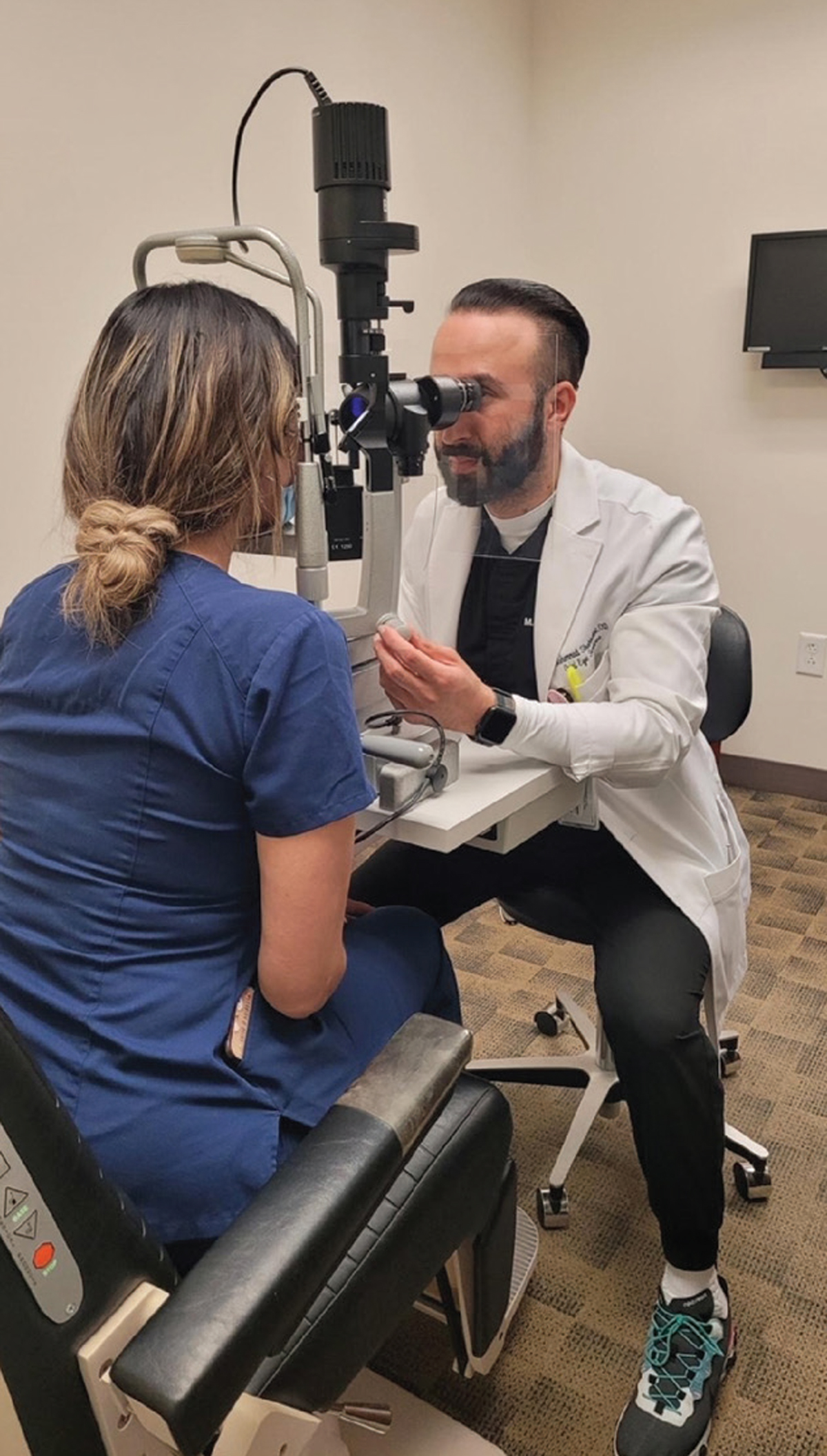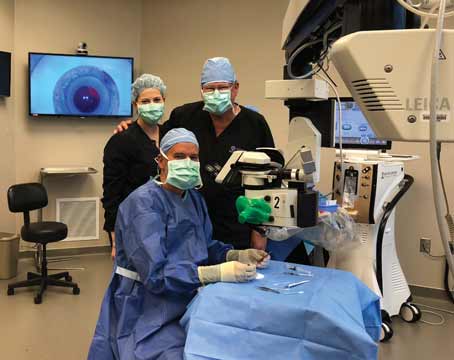Review of Cornea & External Disease In this Issue... Artificial Intelligence for the Cornea Specialist by Christine Yue Leonard DSO and Cultured Endothelial Cell Transplants: A Review by Thomas John, MD, and Anny M.S. Cheng, MD Premium IOLs in Patients with Corneal Conditions by Asim Piracha, MD Diagnosis & Management of Blepharitis by Charles Bouchard, MD, MA |
As populations grow, political landscapes shift, technology and expectations evolve and new generations of young people move into the field of medicine, new challenges are slowly but surely arising. One of the many challenges just starting to impact ophthalmologists in America (as well as many other medical professionals) is a steadily increasing supply of patients needing care, with a dwindling supply of surgically trained doctors able to care for them.
Here, doctors and a practice management expert share their experiences and insights about the reasons for this growing problem, and offer a few thoughts about what might be done to address it in a way that serves all patients in need, while maintaining quality of care.
More Patients, Fewer Doctors
“We’ve known for some time that ophthalmology will be underserved in the future,” says John Pinto, president of J. Pinto & Associates, an ophthalmic practice management consulting firm. “This is part of an overall trend in most of the medical specialties, not just in eye care, and it’s happening for a number of reasons. Twenty years ago, residency training spots were pretty abundant. Then, because of strictures in government financing, those training slots started to go away. The last time I checked, there had been at least a 10-percent drop in residency training slots in the past decade or two. If you squeeze off the supply line of doctors at the same time as you increase the demand for care, the two things will collide.
“My understanding is that we currently have something like 450 residency graduates every year,” he continues. “At the same time, there are something like 550 ophthalmologists retiring every year now, many of them Baby Boomers. If you combine those numbers, in the best-case scenario the number of ophthalmologists is staying even; in the worst case, we’re seeing a decline. Looking at the patient numbers, the United States population is increasing about 1 percent a year, while the number of seniors is increasing about 3 percent a year. Seniors use nominally about 10 times as much ophthalmic care as younger patients. So, while the number of ophthalmologists is steady or declining, we’re seeing an increase of about 5 percent per year in the demand for care.”
 |
|
One way to increase the number of future ophthalmologists would be to increase the number of residency openings. However, it seems unlikely that the government will agree to do that. Furthermore, some doctors have pointed out that the number of surgical cases available for resident training at academic centers is dropping, making hands-on surgical training potentially inadequate for the number of residents already enrolled. Photo: Getty Images. |
Douglas K. Grayson, MD, medical director and chief of glaucoma and cataract surgery at Omni Eye Services in New York and New Jersey, acknowledges that the number of patients seeking eye care is increasing. “Health technology continues to improve and people are more attentive to their health, so they’re living longer,” he says. “Furthermore, our threshold for doing cataract surgery has gone way down; we’re starting to operate on patients with minimal visual complaints. That’s increasing the number of patients who are candidates for the surgery.”
Frederick W. Fraunfelder MD, MBA, associate dean of faculty affairs, and Roy E. Mason and Elizabeth Patee Mason Distinguished Professor of Ophthalmology at the University of Missouri, agrees that this problem isn’t restricted to the field of ophthalmology. “The doctor shortage is a problem throughout the whole health-care system,” he points out. “It’s most pronounced among primary care physicians in rural areas, but it’s true in most specialties in medicine.”
Is It Just the Numbers?
Many observing this developing problem believe that it’s being confounded by factors that have nothing to do with the number of patients and providers. “A second factor in this equation is that a generation ago, almost all residents would graduate and go off to private practice and work like the dickens,” Mr. Pinto notes. “It was a very workaholic age cohort. In contrast, the present generation, God bless ‘em, wants a better work/life balance. The up-and-coming doctors don’t want to put in a lot of extra hours every week. That’s probably a good thing, but it figures into the equation about managing an overload of patients.”
“One reason we have a shortage of ophthalmologic care is that so many of the ophthalmologists we train go into practice during their most productive years but then end up working part-time,” Dr. Fraunfelder says. “Most of us have seen colleagues do this. It may be that they want to raise a family, need to care for a loved one or have experienced a big change in their life. In some cases, they may have burned out. But the reality is that the government bases its spending on residencies partly on the expectation that the doctors who go through training will be caring for patients full-time. The models don’t project scenarios in which many ophthalmologists end up working part-time. I think this is particularly an issue in the field of ophthalmology.
“I feel strongly that the residents we train need to stay in the profession full-time,” he continues. “They should feel a responsibility to do so, and we need to instill this in them during their training. Most of their benefits, salary and health insurance are paid for by the taxpayer through CMS. For them to finish their training and then five years later become part-time isn’t ethical, unless there’s a valid reason for it. I’m convinced that if almost all of our residents practiced full-time we’d have enough coverage to manage all of the patients we expect to see in upcoming years.”
“Another issue is physician burnout, a problem seen all across health care, not just in ophthalmology,” Dr. Fraunfelder points out. “It’s a tremendous problem, and it’s a significant loss for our work force when it happens.
Economic consequences John Pinto, president of J. Pinto & Associates, an ophthalmic practice management consulting firm, notes that standard market forces that shape the cost of services and the amount of demand don’t necessarily apply in ophthalmology. “In almost all areas of human commerce, there’s a very clear relationship between volume and pricing,” he explains. “For example, in the past year and half, house prices have gone up sharply because there was less inventory. The same thing happened with lumber; disruptions affect the price and then the demand. However, in eye care, especially those parts that are third-party funded—and ophthalmology is about 60 percent federally funded through Medicare—the decrease in supply of doctors is not generating a market signal that says, ‘Let’s go ahead and increase the price.’ It’s a fixed-price environment. As a result, we may see more practitioners unlinking from Medicare and deciding to become a cash-based practice. Not many ophthalmologists have done that so far, but I predict we’ll see more in the future.” Mr. Pinto points out that this doctor/patient ratio shift has impacted the amount young ophthalmologists are getting paid. “Base salaries have been soaring in recent years,” he says. “Base salaries for a general ophthalmologist in an urban/suburban area used to fall between $175,000 and $225,000; now they range from $275,000 to $500,000. This increase is especially evident in rural areas, where it’s harder to recruit doctors, whether they’re new graduates or mid-career doctors looking for a new job.” Mr. Pinto notes that a drop in the number of ophthalmologists could have an impact on private insurance payment rates. “Already, in a market that doesn’t have enough ophthalmologists, the ophthalmologists in that market have more pricing power,” he points out. “In that situation you may see stronger reimbursement—maybe 110 or 120 percent of Medicare rates. However, this isn’t true today in a place like Los Angeles, where there’s an abundance of ophthalmologists and the payors have the high ground. They can pay providers at about 80 percent of Medicare allowables. But if there are fewer and fewer ophthalmologists in an area, they should, in theory, be able to drive a harder bargain with the private payor community. “So far, we’re not seeing a lot of that, except in one or two markets here and there,” he adds. “But we may see more of that as the labor shortage increases.” —CK |
“In my experience, ophthalmologists burn out when they focus on things like patient throughput or maximizing efficiency and profits, instead of concentrating on education, service, contributing to the greater good and wearing a lot of diverse hats,” he says. “Focusing on maximizing profits is exciting for five or 10 years, but doctors who do that tend to burn out and retire early. We want our ophthalmologists to feel like they have a career, not just a job—something they can still find interesting 20 years into it.”
Consequences: Hiring a New Doctor
Not surprisingly, more demand and fewer doctors looking for a position leads to practices struggling to find new hires. “We used to have two doctors for every job opening that was posted,” Mr. Pinto points out. “Now we have two jobs for every doctor who’s looking. As a result, practices that want to hire a doctor have to wait longer. In a coastal market, it used to take six to 12 months to find a candidate you could hire to be a new general ophthalmologist in your practice. Now it takes 12 to 24 months—sometimes several years—to find a doctor.
“This is exacerbated in rural or secondary markets,” he continues. “These are wonderful places to practice because they have an abundant population of patients, but it’s problematic to hire doctors because young ophthalmologists typically like an urban, coastal environment. As a result, it can take three years or more to find an ophthalmologist to join a rural practice. This means that practices looking for a doctor have to plan way ahead of time, and small practices and solo practices in these secondary markets have to live with the fact that they may not be able to find a replacement doctor to bring in to do a succession plan with.”
Dr. Grayson notes another factor adding to the hiring challenge. “It’s difficult to hire competent administrators and associates because larger entities such as the private equity firms are aggressively hiring both,” he says. “That’s partly because private equity companies need to replace the older ophthalmologists of the practices they bought. Almost every private equity platform of significance has a full-time recruiter, whereas a private practitioner has to add this recruiting project to his or her busy schedule seeing patients.”
Mr. Pinto says that at any given time, about a half-dozen of his clients are in this situation. “They’re typically planning to retire in a couple of years, so they look for a replacement doctor,” he says. “Many of them eventually realize they’re not going to find someone to buy their practice. So, they delay their retirement, or get more creative in other ways, such as merging their practice with another local practice in town. In some cases I’ve seen practices make a kind of ‘Hail Mary pass,’ offering exceptionally large starting salaries to try to coax people into these secondary markets. Usually, they aren’t able to find a new doctor, so we just close the practice down.”
Mr. Pinto points out that this situation is very frustrating for older doctors and private practices trying to bring in an extra doctor, because they have a line of patients out the door needing help. “Such practices are doing all the things you’d expect,” he says. “Some are saying they won’t be able to grow as much as they’d hoped, and many are digging deep to increase efficiencies. A doctor who preferred to see 30 patients a day ends up seeing 40 or 50 or 60 patients a day to accommodate the market demand, because he or she can’t find a new MD or DO to join the practice.”
Working With Optometrists
“Many practices are dealing with this problem via labor substitution, which is nothing new,” notes Mr. Pinto. “Optometrists have been added to ophthalmology practices for years. If you ask the average general ophthalmologist, the non-subspecialist, what percentage of the visits last week could have been handled by an optometrist, the average answer will be about a third. So optometrists are a really good buffer. Obviously, some ophthalmologists are uncomfortable with that degree of labor substitution, but even if they only let optometrists take over 10 or 15 percent of the practice load, it will help them accommodate the increasing number of patients.”
Dr. Grayson favors sharing the workload with optometrists. He believes the way to manage increased patients with fewer providers is to revamp the traditional model of delivering eye care, so that everyone spends most of their time doing the thing they’re expert at.
“In some practices a young associate joins the practice and does four to six cataracts a week,” he notes. “That’s extremely inefficient in terms of the time management, cost management and overall efficiency. An effective practice model should have surgeons doing mostly surgery, 40 or 50 surgeries at a clip, similar to the LASIK practice model. Preop and postop care should be provided by optometrists. Optometrists are the physician extenders of ophthalmology. That’s where I think the future lies.
 |
| Many practices are hiring multiple optometrists and using division of labor to help the practice manage an ever-increasing number of patients. Photo: Douglas K. Grayson, MD. |
“America has plenty of optometrists and they’re extremely well trained,” he continues. “They’re currently being trained to be more focused on medical disease and clinical skills, and less on refractions, because refractions are becoming more and more automated. Their focus is shifting in ways that make them better suited to act as physician support in ophthalmology practices.
“At the same time, ophthalmologists should be focused on doing what they’re good at,” he says. “Retina specialists shouldn’t be spending all of their time giving injections—that’s an inefficient use of their skills. Their time should be spent fixing detachments, doing vitrectomies, analyzing fluoresceins. Progressive retina practices have physician assistants or other alternatives, like a retired ophthalmologist, to handle the injections. I don’t think we need more retina specialists—we need them to be spending their time on things that only they can do.
“The same is true for glaucoma specialists,” he continues. “Does a glaucoma specialist need to manage an office filled with 75 patients who are stable on their drops? Those doctors should be managing surgery and addressing patients who are complex or are failing despite maximum medical treatment. Clearly, you have to have ophthalmologists in the office to deal with more complicated cases involving glaucoma, cornea or retina, but if we migrated to a model like the one I’m describing, there wouldn’t be a provider shortage.”
Private equity and the provider shortage Private equity firms, which have purchased a significant portion of ophthalmology practices in the United States, have become a major factor influencing how the field of ophthalmology functions, and how it may function in the future. How might they influence (or be influenced by) a provider shortage? John Pinto, president of J. Pinto & Associates, an ophthalmic practice management consulting firm, points out the supply and demand situation of fewer doctors and increased demand is actually not working to the benefit of private equity companies. “The reality is that in this market, private-equity-owned practices are competing with private practices that can afford to pay their associates and partners more,” he explains. “Let’s say you have a practice that has $1 million in collections and a 40-percent profit margin. If that was an independent practice, the doctor/owner would take home $400,000 a year. But if that same practice is transferred into a private equity context, part of those earnings are retained by the private equity company as a way of paying back their investment. The typical division of the profits, in that example, would have about $100,000 going to the private equity company and $300,000 going to the doctor. “That’s fine if the doctor is 68 years old and has gotten the multi-million-dollar payout from the private equity company,” he continues. “However, it’s not so great if the private equity company needs to replace that older doctor and all they can offer is the $300,000 that the practice has available for provider compensation. The private practice that’s in the market to hire that same young doctor looking for a job can offer a higher salary—a full measure of private practice profits. “We often represent young doctors looking for positions, helping them negotiate salaries and terms, and we’re beginning to see these clients getting offers from private practices that are 10 or 20 percent greater than the offers from private equity companies,” he says. “I think this is going to put a real squeeze on the private equity segment of this industry.” Mr. Pinto notes that he saw this coming years ago. “Even 10 years ago it was easy to see that it was eventually going to get harder to hire doctors, and that this might knock a lot of private equity firms for a loop,” he says. “It’s going to be tough for these companies. There will be a lot of doctors buying back their assets for salvage value before this is all over.” Nevertheless, Douglas K. Grayson, MD, medical director and chief of glaucoma and cataract surgery at Omni Eye Services in New York and New Jersey, believes that, on the whole, private equity will be good for the field of ophthalmology in terms of managing an increasing number of patients. “The reason is economy of scale,” he explains. “Private equity companies are able to consolidate practices, centralize human resources, centralize billing, centralize computer systems and then have full-time people maintain those computer systems. This takes a tremendous burden off the doctors. “Of course, the private equity companies are in this for profit, but ultimately they know they can’t control medical decision-making,” he notes. “They don’t ever want to be accused of compromising patient care. They don’t want somebody pointing the finger at them and saying, ‘Look, you’re making us see 25 patients an hour, and that’s not good for patients.’ Meanwhile, the relationship is good in terms of expanding potential for building ASCs, hiring more doctors and hiring more support staff. That reality should help practices manage the increasing number of patients. —CK |
Dr. Fraunfelder also sees engaging with optometry colleagues as a promising way to help manage the provider shortage. “We have a tremendous opportunity to work with them in primary eye care, nonsurgical eye care and rural eye care,” he notes. “Our optometry colleagues are eager and quite capable of working with us. They go to four years of college and major in science; then they go to four years of optometry school, so they’re highly trained. They can take care of common eye disease, and we shouldn’t feel threatened by that. It makes sense to collaborate with them. I know not everyone likes the idea, but I think it’s an important part of the solution.”
The Scope-of-Practice Debate
Of course, the tasks that can be managed by an optometrist are dependent, in part, on state laws governing scope of practice. “Selected states are liberalizing scope of practice for optometrists,” Mr. Pinto observes. “Eventually, it’s likely that incisional care will be granted to optometrists in some states. Obviously this is very controversial, but some ophthalmologists will probably find it acceptable and helpful for managing the patient crunch. Others, of course, will be horrified. Many ophthalmologists are still upset about optometrists being allowed to prescribe therapeutics.”
Dr. Fraunfelder does have serious reservations about optometrists performing any type of surgical procedure. “Our most sophisticated technical school is medical school, and the highest level of competence arises from getting into medical school, completing medical school and doing post-medical-school training, such as residency, fellowships and internships,” he says. “I think our country wants our surgeons to have gone through that. I have a tremendous amount of respect for optometry and optometry education, but surgical interventions should be reserved for doctors who’ve gone through medical school and done the training that’s required. Doctors should educate themselves, not legislate themselves.”
“Partnership with optometry is extremely important from a population health perspective,” says a spokesperson for the American Academy of Ophthalmology. “However, this means a rational division of labor. High-risk, high-intensity diagnostic and interventional tasks should be assigned to ophthalmologists whose training specifically addresses these areas. What doesn’t serve the population well is for the quantity of care to go up and the quality to go down. Our policy and advocacy teams are deeply engaged in the process of establishing and maintaining that balance as we also strive to forge partnerships.”
Dr. Fraunfelder believes that disagreements about scope of practice would be much less common if optometrists were more involved in medical schools. “Today, optometry schools are separate, so optometrists don’t train in our centers,” he notes. “Nevertheless, we do have optometrists in our academic centers. They play a role, especially in the areas of eyeglasses and contact lenses.
“I think if we made optometry a division within our academic centers, we wouldn’t have so many conflicts about scope of practice,” he says. “If optometrists were trained in our academic eye departments, they’d see what an ophthalmology resident goes through to get to that level of training. We’d understand each other better. Why not have the optometry division of our department also train optometry students? I know of academic departments that already do that.”
The “Optometry Model” In Action
“We’ve been using an optometry-friendly model since the beginning of my practice,” Dr. Grayson says. “We’ve always believed in sharing our patients with a team of optometrists. I wouldn’t call it co-management, because that implies that the optometrist is outside of the practice; this is optometry internal to the ophthalmology practice. They see our preop patients, make diagnoses and see postop patients. In our practice model, the ophthalmologist actually has minimal interaction with patients, aside from meeting them and saying, ‘Hi, do you have any questions? Let’s go do your cataract.’ Again, it’s somewhat like the LASIK practice model.”
Dr. Grayson says his doctors primarily spend their time doing the things only they can do. “For example, our optometrists manage many of our glaucoma patients,” he says. “If a glaucoma patient needs a laser, they’re sent to me. If the patient reaches a point at which our optometrist feels medical management and laser has failed, then the patient goes on my schedule. I see the patient and we have a surgical consult. That’s using the area of my expertise.
“The other advantage of this system is that doing what we’re most qualified to do all the time helps us become expert at it and remain so,” he points out. “Our pediatric specialist mostly just sees patients who need surgery. He can do 30 cases in a row and do them well. If he only did one case a month and spent the rest of his time measuring kids’ vision, he wouldn’t be as good at the surgery.”
Dr. Grayson notes that the younger ophthalmologists joining the field are less willing to put in extra hours, but says his practice model results in that factor not undermining the amount of care the practice can provide. “The young doctors come in expecting to have help from techs and optometrists,” he notes. “They expect to show up at 9:00 a.m. and leave at 5:00 p.m. It’s a feeling of entitlement that I don’t think is justified, but on the flip side, the kind of practice we’ve created makes that workable—even for me. Having a huge optometry support staff and techs, I can go in, see 100 patients, then go to the OR and do 60 cases, and still be done at a reasonable hour.
“We have one associate who always leaves at 5:00 and goes home at noon on Fridays, but she’s doing 1,600 cases per year,” Dr. Grayson adds. “That’s possible because of the system and support team we have. Those numbers were unheard of in most practices 25 years ago, but to her it’s an average day. It’s annoying to see associates come in and act as if this was expected, but this system does make them more efficient.”
Dr. Grayson notes that for this practice model to work, egos have to be set aside. “If you decide that you’re the only one qualified to do many of these chores, you’re going to have a hard time managing more and more patients,” he says. “And with automation handling so many of the measurements today, we don’t need to personally take them. I used to have to look at a patient’s macula to see if there was an epiretinal membrane before doing cataract surgery, because I didn’t want the patient to have a subpar result. Now an optometrist shows me the OCT; if I see an ERM I proceed accordingly.”
Dr. Grayson says this practice model works very well. “I think this is where the future of ophthalmology lies, although it may take a while for the field to get there,” he says. “When I first spoke about this model years ago, I got hate mail! Today, bringing in optometrists is much more widely accepted. Besides, ophthalmologists coming out of training today are more open-minded and understanding about integrating with optometry. These young ophthalmologists expect more support services, whatever kind of practice they go into.
“The bottom line is that our practice model delivers patient care at a level that’s way beyond what most general ophthalmologists can offer,” Dr. Grayson concludes. “My optometrists see the patients first, and they’re top-notch. We don’t miss stuff. I’m proud of our model. I think we do a great job.”
Create More Residency Slots?
Another way to address the shifting doctor-patient ratio would be to train more ophthalmologists. This would require creating more residency training slots, however, and that could be easier said than done.
“Ophthalmology residency spots have always been sought after,” Mr. Pinto notes. “It’s a great specialty that has a lot going for it—lifestyle, economics, intellectual fascination and more. I can’t imagine that there’s ever been an ophthalmology residency program in America that had trouble filling all of their available slots. So one way to improve the imbalance between providers and patients would be to get more federal funding to open up more standard residency slots.”
“Increasing the number of residency slots is a potential solution to the provider shortage,” agrees Dr. Fraunfelder. “However, I doubt that CMS is going to increase spending on ophthalmology. In fact, they’re targeting ophthalmology for decreased spending. So they’re probably not going to let us have more residency slots.”
Dr. Grayson believes increasing residency slots wouldn’t be the best solution to this problem in any case. “We don’t need more residency training,” he says. “In fact, if you try to train more residents, you’re doing them a disservice, because they can’t be trained as well today. It’s not that the instruction is inadequate, it’s a lack of hands-on case experience.
“Medicare and Medicaid insurance changes have limited the advantages of having your cataract done by a resident in a hospital eye clinic, versus going to a large practice,” he explains. “As a result, there’s been a decline in patients going to clinics, which means residents don’t get to do as many cases during their training. I can see the difference in the new residents coming out. They may know more about phaco surgery than we did at that point in our careers, but they don’t necessarily know what to do when things go wrong; they haven’t had the breadth of experience in their training.
“In this climate we still need academic centers to manage the special, unusual cases, but not for routine care,” he says. “So I don’t think we should be opening up new residency slots and training more people. We don’t need to train more ophthalmologists. We just have to better utilize the ones we’ve got.”
“The sum total of the workforce is a combination of people coming in and people going out,” a spokesperson for the American Academy of Ophthalmology adds. “Residency programs are limited by the graduate medical education spots made available to them by Medicare. While residency funding has increased recently—targeted to underserved areas and regions with newly established hospital training programs—hospitals infrequently consider assigning spots to ophthalmology. That’s a problem. On the other side of the equation—people coming out of these programs—sustainable reimbursement is a high priority if skilled individuals are going to be retained. Both issues point to the need for rational federal support through Medicare. Our advocacy team is intensely focused on Medicare payment reform.”
Other Possible Solutions
A few other possible ways to address the provider shortage are worth mentioning:
• Allow more foreign ophthalmologists to immigrate. “One solution to the doctor shortage would be to liberalize foreign medical graduate admission to the country,” Mr. Pinto notes. “There are plenty of offshore ophthalmologists who are well-trained, who would be a great addition to the profession in America. However, our laws make that quite challenging.
“This is not my area of expertise, but my understanding is that even for countries with whom we have a close relationship, democracies that have great educational systems, vetting protocols and the rest, it’s tough,” he says. “In order to become an ophthalmologist over here, you not only have to jump through the hoops required to change your citizenship, you have to repeat a significant amount of your training.
“Obviously, some people actually do this,” he adds, “but it’s quite a challenge. Unless the regulations are liberalized, it will continue to be difficult to see foreign medical graduates as a good solution to this problem.”
“This is mostly out of our control,” notes Dr. Fraunfelder. “We aren’t policy makers for the government, and we don’t control who gets visas. Most of the waivers that occur at the government level are given for primary care physicians, not ophthalmologists. So it’s difficult to get eye-care specialists here from other countries, even though they’re very well trained. They have to take additional tests and jump through a lot more hoops than U.S. graduates.”
• Allow private-practice-based residencies. “Currently, an ophthalmology residency training slot has to be tied to a university-affiliated program,” Mr. Pinto notes. “That’s not the case for fellowship. If you want to do a plastics fellowship and you already have a residency in ophthalmology, you can go to Mike’s ophthalmology clinic and get training from Mike for a couple of years and be able to call yourself a fellow of a plastic fellowship program, with varying degrees of formality. So one possible way to compensate for the limited number of traditional residency spots would be to allow private-practice-based residencies. A doctor might bring someone into the practice who’s graduated from medical school and finished their internship, and then spend three years teaching them to be an ophthalmologist.
“Certainly, some large practices might like to get into that activity,” he notes. “Such an arrangement would create a stock of future doctors for their own clinic, while also giving the practice extra hands during the training period.”
However, Dr. Fraunfelder has reservations about having students do residency outside of a medical school environment. “I’d prefer that our residents learn in a culture of research, discovery and education, which they’re most likely to find here,” he says. “We cultivate faculty who are good teachers and good clinicians and surgeons, individuals who are highly motivated to teach and to be around learners. Many of the opinion leaders, scientists, doctors with grants, doctors with publications and doctors who are the editors of journals are in the academic health centers. You want your trainees to be in that environment.
“I don’t think it’s a good idea to be trained in a practice where there may be more of a focus on the business of ophthalmology,” he adds. “That’s important, of course, but it’s just one part of what doctors in training need to learn. I’d hate for trainees to lose sight of how important it is to be an expert in the science of ophthalmology and the art of patient care. I think they’re more likely to get the training they need in this kind of academic environment.”
• Medical tourism. “Another option for dealing with excess patients would be sending some of them out of the United States,” Mr. Pinto points out. “We see this to some extent in reverse—some Canadians come to northern U.S. states for cataract surgery, to avoid the wait for government-paid surgery at home. However, I think that sending patients out of the U.S. might not happen until the imbalance grows severe, when we really have people waiting long intervals to get appointments for care. That might be pretty far down the line.”
Making the Best of It
Mr. Pinto points out that only so much of this changing doctor-patient ratio is under the profession’s control. “An individual doctor can’t change the macro factors that are causing this problem,” he says. “He or she can hire optometrists or choose to work harder themselves. But the options for action are limited. The reduction in training slots, for example, is a problem for the federal government to solve.”
“Population growth and aging doesn’t happen in a vacuum,” notes a spokesperson for the American Academy of Ophthalmology. “Technology changes that can enhance the productivity of physicians also occur. In partnership with a number of academic institutions across the country, the AAO is actively engaged in research aimed at developing clinically relevant tools to enhance quality, efficiency and cost. Furthermore, there will be an increasingly important role for well-trained supporting personnel, including medical assistants, technicians, orthoptists and so on. The Academy is committed to enhancing our educational and professional development support for these important team members.”
“Philosophers have pointed out that some problems can be solved, while others are things we simply have to live with,” Mr. Pinto concludes. “The growing gap between the number of ophthalmologists and the number of patients needing care could turn out—at least in part—to be one of those things we’ll just have to live with.”
Drs. Grayson and Fraunfelder have no financial ties relevant to anything discussed in this article. Mr. Pinto can be reached at pintoinc@aol.com.








